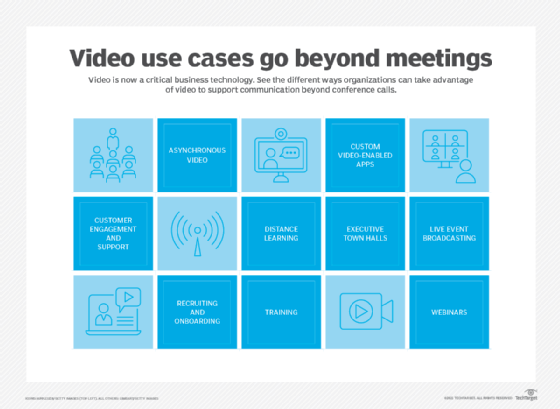
Getty Images/iStockphoto
3 steps for an effective corporate video strategy
A video-first business goes beyond conferencing to support productive employees, streamlined workflows and new creative perspectives.
Over the course of the COVID-19 pandemic, people quickly got comfortable with using video meetings in place of physical meetings. Many even replaced phone calls with video at some points. However, there is a lot more to being a video-first business than just supporting remote work by giving everyone a Zoom, Microsoft Teams or Webex account.
The potential power of video in business goes beyond simply including remote workers in daily meetings. A video-first business uses video to communicate with team members, along with partners and clients. A true video-first business also uses video beyond meetings. A corporate video strategy could include marketing, training, promotions, webinars, podcasts, interactive livestreams and social media clips.
However, transforming a company into a video-first business is not easy. It takes a lot more than buying cameras and related video gear for teams. Technology is not the issue here. In fact, the technology has been ready for quite some time. The challenge is the culture. Follow these three steps to kick-start your company's initiative for adopting a corporate video strategy.
1. Embrace video
Organizations aren't always thinking of incorporating video when launching new work programs or initiatives. Instead, things stay the same, with blogs, PDFs, infographics and other flatly written copy. This could be due to people still thinking video is complicated, expensive and only for video experts. Or simply that video is not worth doing.
To change this mindset, organizations must embrace the power of video. The best way to do this is to continue using video as we did during the pandemic, rather than going back to the phone for communication. Be sure your team doesn't take the benefits of video communication for granted.
The power of face-to-face communication -- regardless of physical location -- may be the norm today, but it should still be noted and appreciated. The connections made between team members that meet over video result in better and more quickly produced work, which provides more productivity and profit for companies.

2. Measure video effectiveness
Video shouldn't be an afterthought as a project element, rather it should be expected. Your team shouldn't be asking, "Should we make a short video for social media as part of this project?" Instead, think, "Naturally, video will be a part of this project because we are a video-first company and we use the power of video to stand out from the competition."
To get to this point, measure the effectiveness of video use, and provide feedback to teams. If a team creates a print promotion that results in 10 sales leads and a video promotion that results in 100 leads, make sure they know that. If customers dealing with their reps over video report higher satisfaction than ones using the phone, make sure customer reps are aware. Your teams want to be effective, and they will become video-first workers if you show them how much more effective they are with video.
3. Provide training to users
Finally, some tech and training can't hurt. Many workers may not be aware that they can join a video meeting alone and click record to make a talking head video for social media. Make sure your team is aware of, and comfortable using, their existing video tools. If you want to go beyond that, you can encourage one team member to be your "video hero" and learn a little video editing and production.
Companies who are more serious about adopting a corporate video strategy should consider investing in a small studio space at the office, with a professional background, lighting and higher-quality camera gear. However, all that equipment isn't required for a video-first business -- desktop video and a little editing can go a long way. It all depends on the culture and mindset of the company.
A video-first company has a great advantage over its competition. Using video for internal communication improves productivity and worker satisfaction, while using it for external communication puts a human face on the business. The effect of video over print for marketing and promotion is beyond dispute -- TV commercials sell more product than newspaper ads. However, it can't be expected that all working teams will use video simply because the technology is available to them. Even in this video-friendly post-pandemic world, most companies simply do not yet have a video-first culture.








